Maintaining indoor humidity is essential for a healthy and comfortable living environment. High humidity may create problems like mold, mildew, and structural damage to your house and negatively affect your health. Dehumidifiers are valuable devices for addressing these challenges; however, their effectiveness depends mainly on proper placement and usage practice. The essay aims to provide complete information about how the dehumidifier should be placed and how to use it. By mastering these key things, you can consistently achieve maximum output from your dehumidifier, ensuring you have a safe space without moisture for you and your family to use.
What are the ideal rooms for placing a dehumidifier?
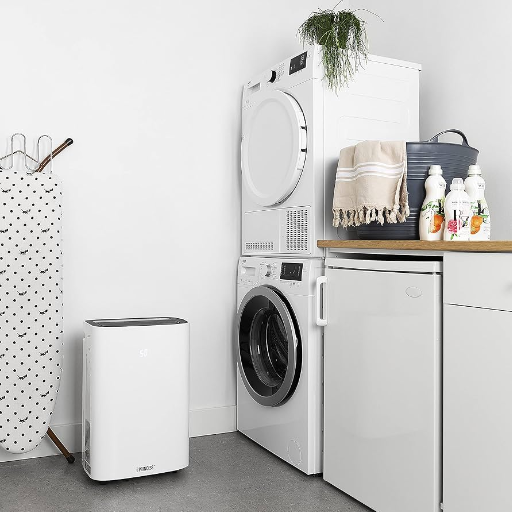
Rooms ideal for a dehumidifier are those with high dampness and moisture levels. Basements, bathrooms, and laundry rooms belong to these categories. Poor ventilation and frequent use of water commonly cause them to be moist. Basements often experience high humidity due to their subterranean nature. Thus, they become hotspots for mold and mildew. Bathrooms are also prone to moisture problems since they are constantly exposed to steam from showers or baths. The same applies to laundry rooms, where washing machines and dryers cause significant humidity. If a bedroom or living room feels damp or has musty odors, it may also benefit from a dehumidifier in addition to those mentioned above. When choosing such room types, the dehumidifier helps reduce humidity levels, thus mitigating structural damage and promoting better indoor air quality.
Which areas of the home have the highest humidity?
Areas with the highest humidity in a house include basements, bathrooms, and kitchens. Basements are often poorly ventilated and may have moisture leaking from the surrounding soil, raising the humidity. Bathrooms have always been known to produce high moisture levels due to hot showers and baths if they are not properly aerated. Cooking, boiling water, and dishwashing also create steam, making kitchens another major source of humidity. To show the importance of proper humidity control and ventilation, these areas are usually quite prone to dampness, mold growth, and other associated issues.
How do we identify problem areas with excess moisture?
When identifying areas with excessive moisture problems, I first check for visible signs such as condensation on windowsills, peeling paint, or discolored walls or ceilings. Besides checking for warping or soft spots on wood or drywall surfaces, I would also be aware of any musty smell that could imply mold growth. In addition to this approach, it is helpful to note down readings from a hygrometer in areas like bathrooms, kitchens, and basements; anything that stays consistently above 60% relative humidity sets off an alarm bell. Finding early signs of trouble spots during regular maintenance rounds when conducting inspections of at-risk areas, such as near plumbing fixtures or poor air circulation spaces, helps me identify potential problem sites more quickly than waiting until they become serious issues.
Should I put a dehumidifier in the bathroom?
To reduce humidity in such a case, one can put a dehumidifier inside the bathroom. Bathrooms attract moisture due to daily activities like showers and baths, which may increase the relative humidity beyond recommended levels of 50-60%. Consistent high humidity leads to mold growth, mildew, and structural damage. An appliance that reduces moisture from the air is essential in maintaining optimum humidity, thus minimizing mold development. A dehumidifier may not always be necessary for an adequately aired bathroom, such as an exhaust fan or window that allows moist air to escape effectively. However, it is an effective solution for bathrooms with poor circulation or naturally high moisture content regions to protect your property and enhance indoor air quality.
How do I choose the best location within a room?
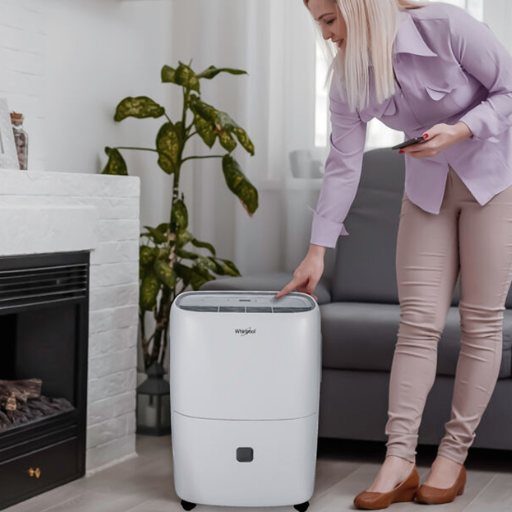
Choose a dehumidifier location in your room with water circulation, preferably near the moisture source. This will prevent poor performance, as corners and obstructions by furniture may lead to its inefficiency. Ensure that the flat surface on which the dehumidifier is placed is stable and away from walls to have good airflow around it. Additionally, during operation, close windows and doors to enable it to maintain ideal humidity levels.
What factors affect dehumidifier placement?
Several factors determine where you should place your dehumidifier. First, I put it near the primary source of humidity, like a bathroom or basement, where the dampness begins. I avoid placing it very close to walls or furniture or hiding it behind corners too tightly for adequate air circulation. I also check if it lies on an even surface to prevent shaking or making noises while in use. Finally, I ensure that I shut down all windows and doors of my room, creating a controlled atmosphere that maximizes dehumidifier efficiency.
How vital is airflow for dehumidifier efficiency?
The efficiency of one dehumidifier is significantly affected by airflow. Appropriate airflow enables the humid air to be effectively sucked into it, thus allowing for maximal efficiency of this gadget. Such devices cannot extract moisture in large or poorly ventilated rooms without adequate air movement. As a result, they consume additional power and become less efficient. To optimize airflow, dehumidifiers should have enough space—usually about 6-12 inches on all sides—so that the air can move freely. Also, ensure that the air filter is cleaned and maintained regularly so that it does not have any obstruction, which might hinder proper air circulation in the room. Proper airflow increases the device’s ability to control humidity and its durability.
Should I place the dehumidifier near windows or doors?
Situating a dehumidifier close to windows or doors could be advantageous if these are the primary sources of humidity or water infiltration. Nonetheless, I do not allow this unit to face sunlight directly or sit within a draft, which would lower its effectiveness. Generally, placing it centrally on a floor leads to better overall moisture control, though the exact placement depends on the portions with the highest humidity levels.
Can I use a single dehumidifier for the whole house?
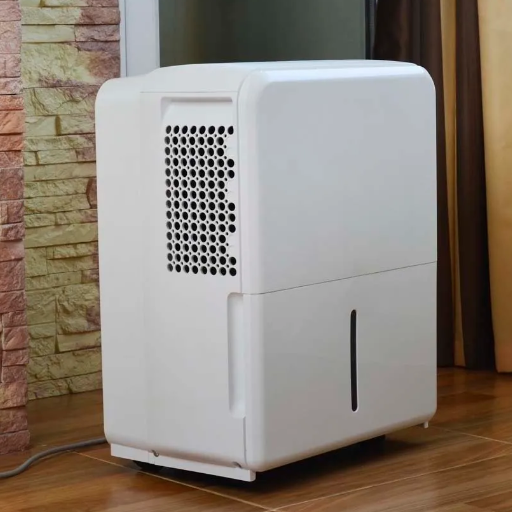
It’s possible to use only one dehumidifier for a whole house, but this will depend on the size and capacity of the device. Whole-house dehumidifiers are designed to control humidity in larger spaces and can be integrated into HVAC systems for uniform moisture management everywhere. However, for portable dehumidifiers, multiple units are often more practical in areas with the highest humidity levels because a singular unit may not adequately cover an entire house, especially where it is multi-level.
What is the best central location for a whole-house dehumidifier?
For a whole-house dehumidifier, the best central location is usually near the HVAC system, like in the basement, utility room, or crawl space to connect directly to ductwork. This positioning allows for optimum air circulation and moisture control throughout the home by capitalizing on the existing HVAC system’s airflow patterns. Moreover, this place often experiences high humidity rates, making it appropriate for effective performance. Consequently, correct drainage should be ensured while enough space should also be provided for easy maintenance accessibility.
How effective are portable dehumidifiers for multiple rooms?
While a single portable unit will work best for one room or an open-concept area with good airflow, from experience, this cannot be said about multiple rooms. However, some barriers like walls and closed doors will limit effectiveness as the dehumidifier cannot circulate air efficiently between spaces. For larger areas, higher-capacity models can be used; nevertheless, achieving consistent results across multiple separate rooms may involve either using more than one dehumidifier or incorporating a whole-house solution for optimal performance.
What are the benefits of placing a dehumidifier in the basement?
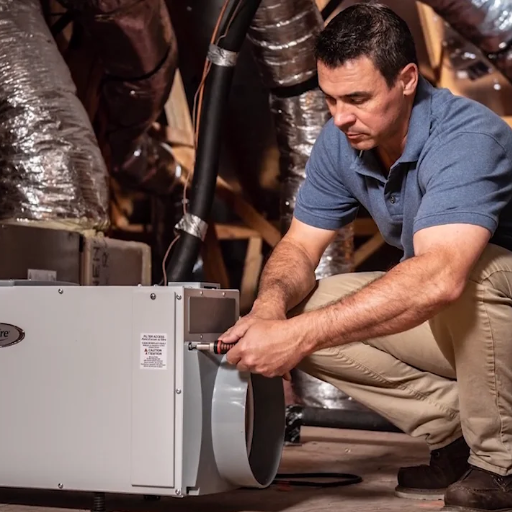
Several key benefits are associated with placing a dehumidifier in the basement. The below-ground positioning of basements generally causes high humidity levels because of limited ventilation and the possibility of water seepage. In addition, a dehumidifier is very effective at reducing moisture, thus preventing mold and mildew, which can damage materials that makeup structures and also lower air quality. It also protects items stored in it, such as furniture documents or seasonally used equipment, from any damage from excess dampness. Besides this, maintaining appropriate humidity levels in the basement helps reduce musty odors that may occur when there is too much moisture, thereby increasing overall comfort in space and avoiding humidity migration to the home’s upper floors.
How does a dehumidifier help with basement moisture issues?
Dehumidifier works by sucking out extra water found in the air while at the same time reducing humidity to levels ranging from 30-50%. This prevents condensation on surfaces and inhibits mold growth, mildew, or dust mites. By keeping conditions dry, it protects structural elements like walls and floors against moisture-induced damage and extends the life span of stored goods. Modern dehumidifiers come with hygrometers for accurate humidity adjustments and auto-drain systems that ease maintenance work and run efficiently, saving costs over long periods. Such efficacy makes them perfect for enhancing indoor air quality, conserving infrastructure, and improving comfort within basements.
Should I put the dehumidifier near the sump pump?
Placing your dehumidifier near your sump pump can be effective, especially when controlling humidity levels in this area because water collection usually leads to high humidity levels. In addition, when placed close to your sump pump, drainage would be simplified in case you have a continuous drain hose attached to your dehumidifier. However, ensure enough space for fresh air to flow around the unit to function optimally.
How should I position a dehumidifier in a bedroom?
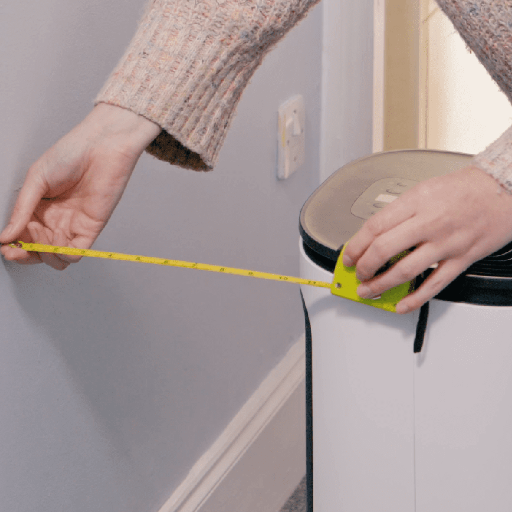
When positioning a dehumidifier in the bedroom, it should be in a location that allows unobstructed airflow. This can be ideally near the center of the room or along a wall with plenty of space left on all sides. Ensure at least 6-12 inches of open space around walls, furniture, or curtains to maximize air circulation. Avoid putting them near heat sources such as radiators or vents. These can interfere with their efficiency. If you are concerned about noise, move it away from your bed.
What’s the optimal distance between the bed and the dehumidifier?
For best results, close windows and doors while you run the dehumidifier to prevent excess moisture from entering the room. The ideal distance between the bed and the dehumidifier is usually 3 to 6 feet long. This way, moisture can be effectively removed without directly exposing one to drafts that may emanate from it or any other form of noise it generates. Placing it too close might cause discomfort due to air drafts or operational sounds; placing it too far could reduce its effectiveness.
How can I minimize noise when using a dehumidifier in the bedroom?
To minimize noise when using a dehumidifier in the bedroom, I put it on a flatboard to reduce sound produced by vibrations and enhance its position. Alternatively, I may choose one with a low decibel rating or a dedicated noiseless model. Lowering the fan speed to a lower level will also decrease noise output without affecting much of its effectiveness. Sometimes, I prefer placing the unit a little far from my bed.
Are there any places I should avoid putting a dehumidifier?
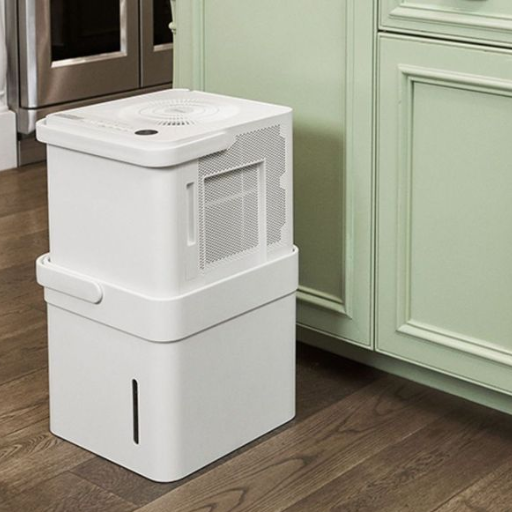
Certain places are not ideal for keeping a dehumidifier. Avoid putting it directly against walls or furniture since that can cause air blockage and reduce efficiency. Also, avoid placing the device near heat sources like radiators or cookers lest this obstructs its functioning or leads to overheating issues. Furthermore, you should never use this equipment under highly polluted and extremely dusty conditions because it might fill up its filter, disrupting its operations entirely. Finally, ensure that it is not placed in areas where water may drop right onto it, such as the dripping pipes below, to maintain the safety and proper function of the gadget.
Is it safe to place a dehumidifier in tight spaces?
Placing a dehumidifier in small rooms is not recommended because air circulation around it is crucial for efficient operation. For air to move freely, dehumidifiers need ample space around them—usually at least twelve to eighteen inches from walls or objects. Limited airflow in tight spaces can cause the unit to overheat or function inefficiently. In confined spaces, the heat produced by dehumidifiers might collect, which leads to high ambient temperatures and low efficiency. The best way is to locate it in a well-ventilated place and maintain it regularly, primarily through cleaning filters.
Should I keep the dehumidifier away from electrical outlets?
As long as I take proper precautions, it is generally safe for me to situate a dehumidifier near an electrical outlet. To avoid any electrical dangers, I ensure the outlet and the plug sockets are dry and in good condition. Moreover, using extension cords with these devices should be avoided unless there’s no other option, as this could result in overheating problems. I can safely use a dehumidifier near an electric source by plugging the unit into a grounded outlet and keeping the area dry around it.
How do I ensure proper drainage when placing my dehumidifier?
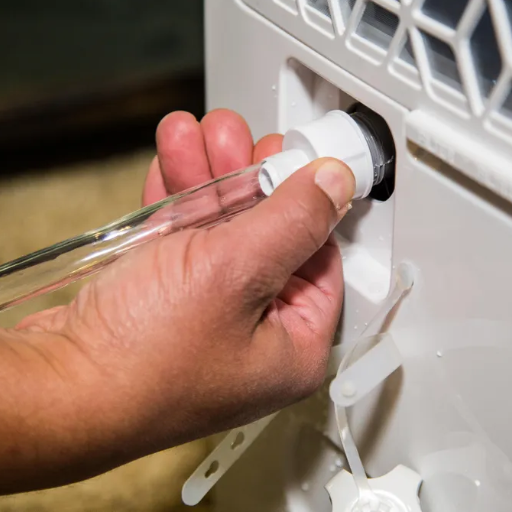
You should first establish a drainage approach to use, either manual or continuous, for drainage purposes when setting up your dehumidifier. For hand-operated draining, empty water collection buckets regularly to prevent overflow. If you go for a constant process, hook up the unit’s outlet to an appropriate pipe and make sure it is directed towards the drain. For instance, so that the water goes down without any blockage and ensures smooth flow of water. Always check hoses for secure connections and keep them free of kinks so as not to hinder adequate drainage.
What are the best options for continuous drainage?
The top choices whilst setting up continuous drainage for your dehumidifier are floor drain, sink, or via sump pump system. Among all these, floor drain is the easiest way since gravity automatically directs the flow without needing anything else. Ensure the hose is secured and sloping down towards the drain to prevent backflow. Alternatively, one can connect the hose to a sink without a floor drain. Clamp or tie down the hose while ensuring the sink can withstand water output in volume. Lastly, where areas are susceptible to higher humidities or elevated discharge points, connecting the unit to a sump pump system ensures effective and automatic water disposal. Regardless of your chosen method, regularly check fittings and ducts for obstructions or leaks to sustain optimal performance.
How often should I empty the water tank based on placement?
Emptying the water tank will depend on the humidity level in the dehumidifier area and how often you use your dehumidifier. In rooms with moderate relative humidity (40-50%), I tend to empty it once every two days or daily. Nonetheless, in a high-humidity basement, I have had to drain water from my appliance more than once daily, especially when it runs non-stop. Thus, placing the unit close to a floor drain could eliminate the need for manual emptying since this feature can remove water automatically through continuous draining systems. One must frequently check the level at which their container fills up.
References
Frequently Asked Questions (FAQ)
Q: What is the best place to put a dehumidifier in my home?
A: The best place to put a dehumidifier is typically in areas with high humidity levels and poor air circulation. Common locations include basements, crawl spaces, laundry rooms, and bathrooms. For maximum effectiveness, place your dehumidifier in a central location within the room, away from walls and furniture, to allow for proper airflow.
Q: How do I know if I need a dehumidifier?
A: You may need a dehumidifier if you notice signs of excess humidity in your home environment, such as condensation on windows, musty odors, mold growth, or damp spots on walls and ceilings. If your indoor relative humidity consistently stays above 50-60%, it’s a good indication that you could benefit from using a dehumidifier.
Q: How do I use a dehumidifier to dry a damp room?
A: To dry out a damp room with a dehumidifier, first close all windows and doors to prevent additional moisture from entering. Then, place the dehumidifier in a central location and set it to maintain a relative humidity between 30-50%. Empty the water collection tank regularly or set up continuous drainage. Run the appliance continuously until the room feels dry and comfortable.
Q: What should I know before buying a dehumidifier?
A: Before buying a dehumidifier, consider the size of the area you want to dehumidify, the average humidity levels in your region, and the unit’s capacity (measured in pints of water removed per day). Look for automatic shut-off, adjustable humidistat, and Energy Star certification. Also, consider noise levels and ease of maintenance when choosing the best dehumidifier for your needs.
Q: Where should I put my dehumidifier in the basement?
A: In a basement, put your dehumidifier in a central location with good air circulation. Keep it away from walls and corners, and elevate it slightly off the ground if possible. If your basement has multiple rooms, consider placing the unit near the most humid area or rotating its position periodically to ensure even moisture removal throughout the space.
Q: How often should I run my dehumidifier?
A: The frequency of your dehumidifier running depends on your situation and humidity levels. You may need to run it continuously in areas with consistently high humidity. Running it for a few hours daily or when humidity levels rise above 50-60% may be sufficient. Use a hygrometer to monitor humidity levels and adjust your dehumidifier usage accordingly.
Q: Can I use a dehumidifier with my HVAC system?
A: Yes, you can use a dehumidifier with your HVAC system. While air conditioners remove some moisture, a dehumidifier can provide additional humidity control, especially in higher-humid conditions. Consider a whole-house dehumidifier that integrates with your HVAC system, or use portable units in specific problem areas for optimal results.
Q: How do I maintain my dehumidifier for optimal performance?
A: To maintain your dehumidifier, regularly clean or replace the air filter, empty and clean the water collection tank, and wipe down the exterior and air vents. Check the coils for ice buildup and clean them if necessary. Ensure proper air circulation around the unit and avoid dust and debris. Follow the manufacturer’s instructions for specific maintenance requirements for your model.



